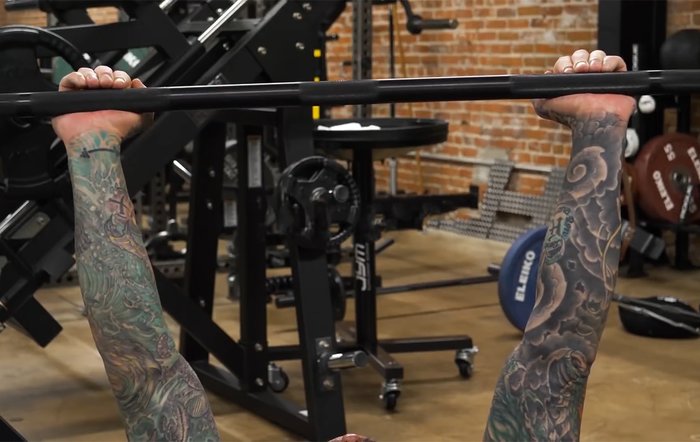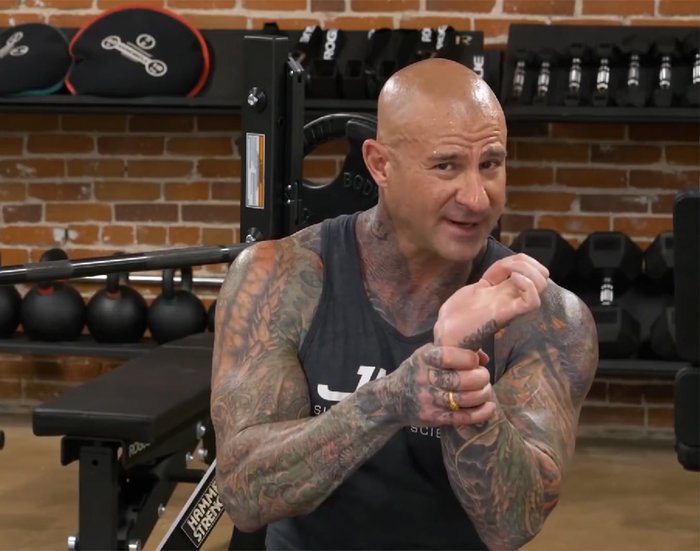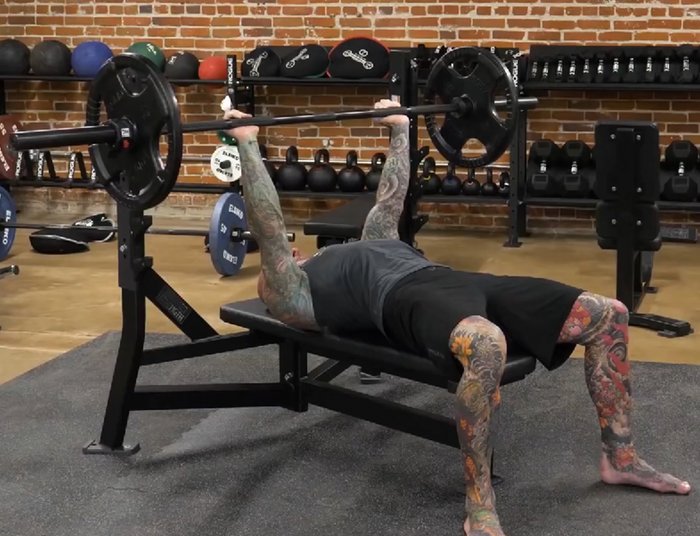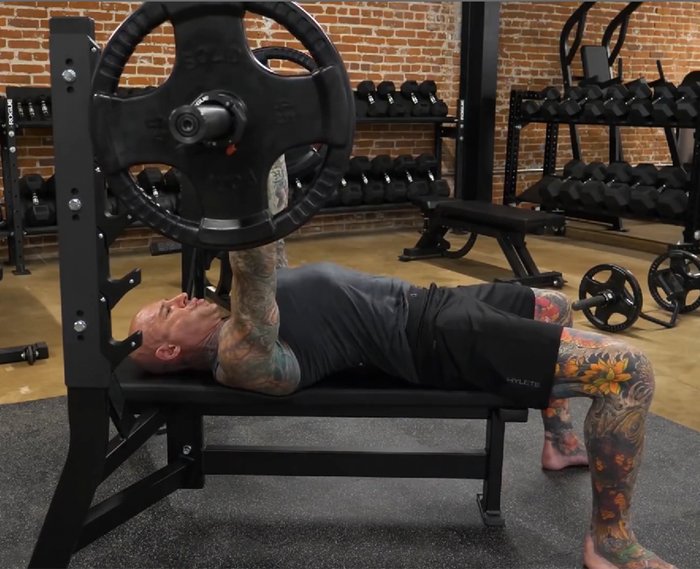To outsiders and newbies, the bench press is just one of those macho lifts you do to impress people. A good bench, though, requires mastery of a number of subtle points of form. Lifting for maximum weight calls for a few small but important refinements in the position of your fingers, hands, elbows, shoulders, and back—all the way down to your legs and feet.
If you're ready to up your bench press game, use this guide to dial in form and technique. Each one is a stepping stone to moving more weight, getting stronger and adding muscle as you lower your risk of injury.
Keep an Open Mind About the Open Grip
Any good discussion about bench press biomechanics has to start with the fundamentals of how to grip the barbell. This may seem to some people like a minor detail—it's anything but. The grip you choose determines how the force from your pecs and your arms will be transferred to move the bar. If you don't have a strong grip on the bar, your ability to generate and build strength will suffer.

The closed grip, with your thumb on the opposite side of the bar from your fingers, is the safest way to prevent the bar from falling on your chest. However, I'm a big proponent of using an open grip, also known as the suicide grip, because the thumb is on the same side of the bar as the fingers. The downside of this grip is that the bar could roll out of your hands, but that risk is more than outweighed by the upside. Trust me when I say that using an open grip is the best way to maximize both your strength and your chest development when pressing.
It all has to do with where the bar sits in the hand. When you use a closed grip, the bar sits higher on the hand, meaning it rests more on your fingers. Holding the bar in this position requires more wrist joint involvement. The problem is that the wrist is a weaker joint compared to the elbow and the shoulder. If your weak link is your wrist, it's going to limit the amount of weight you can bench.
Holding the bar with an open grip keeps the bar lower on the palm, positioning the bar directly over your forearm bones. When you drive the bar up off your chest, the transfer of force will go directly through your forearm bones right into the bar. With a closed grip, the force must go through your forearm bones to your wrist bones and then to the bar.
Hand Position Need Not Be a Mystery
The best grip width I've found to help increase strength, avoid injury, and help with chest development starts with measuring your biacromial distance, which is the distance between the acromion, or bony points on your shoulder blades.

To find your biacromial distance, measure the distance between these two points and multiply it by one and a half times. This is how far apart your hands should be placed on the bar. The biacromial distance will help protect your shoulder joints from injury, maximize your strength on the bench press, and help you hit more of the upper pec muscle fibers.

Keep Your Elbows Close In
If you bench press with your elbows flaring out away from your sides, chances are you're eventually going to injure your shoulder. The best technique is to tuck your elbows in at 30-60 degrees from your torso. It should feel almost as if you're holding a softball or grapefruit in each armpit while you're lifting. The last thing you want to be doing is bench pressing with your arms completely perpendicular to your torso.
Biomechanically, keeping your elbows in this position allows your lats to assist with the press, which helps in two ways. First, engaged lats can help support your shoulder joints from injury. They're also going to help you apply more force to the bar.
A Good Bench Starts From the Ground Up
There's still more to a good bench press that your grip, hand placement, and elbow position. Where you place your feet is important, too. Your foot position on the floor, much like your grip on the bar, is critical to the amount of force you will be able to apply to the bar. When you lift, you start force production from your lower body, transfer it through your hips and torso/spine into your shoulders and pecs, through your arms, and into the bar.

For bodybuilders mainly interested in maximizing chest development, keeping both feet flat on the floor is perfectly fine. If you're a powerlifter and more interested in how much you can lift than how developed your pecs are, get up on the balls of your feet. By pulling your feet back more, you're able to generate more force to drive more weight up, and drive it with more explosive force.
Making the Bench a True Full-Body Exercise
When performing this full-body movement, make sure your glutes and back are involved in each press. Your glutes should be flat on the bench, and there should be a slight arch in your back, such that your upper back, shoulders, and glutes are the only body parts in contact with the bench.
Maintaining this arch in your back will help to protect your lower back, which can otherwise be at risk when you bench press. And proper back position is one more way to ensure that you maximize the transfer of force through your body and to the bar.
The Correct Bar Path is Not a Straight Line
Another crucial point to discuss is bar path. When you're bringing the bar down to your chest, you want to be bringing it down somewhere between the bottom of your chest and your upper abs. If you're coming down to where your nipples are or higher, the bar is too high on your chest. This position can cause your elbows to flare out too much, which, as you now know, can lead to shoulder injury.

When you drive the bar up off the chest, you don't want to drive it straight up over your chest. Instead, you can generate the most force by pushing it both upward and forward toward your face. Getting this path down may take some practice, but you'll soon see the benefit.
Putting It All Together
Let's combine all these tips into what I consider a biomechanically ideal bench press. First, lie down on the bench and, instead of a typical bodybuilding-style approach with your feet flat on the floor, pull your feet back more and go up onto the balls of your feet. Your shoulders, upper back, and glutes should be supported by the bench, putting an arch in your lower back. With your body in this position, apply maximum force to the bar as you move it from your lower chest to above your upper chest area, just below your chin.
Slowly lower the bar under control to your lower chest. Pause for just a second at the bottom, then drive the bar up with as much force as possible. Again, the force should start at your feet, transfer through your legs, through your hips, through your torso, shoulders, and arms and into the bar. That's one sweet bench press. Now keep it going through the rest of your sets and reps.
Looking for a way to program that bench press? It's featured prominently in all three of my Bodybuilding.com BodyFit Elite programs, but if a heavy bench is your goal, you can't do better than Shortcut to Strength. That programming, along with solid technique, proper nutrition, supplementation, and motivation, will help you move mountains.
Find more great training programs like this, including my popular #TrainWithJim full-body workout series, on JimStoppani.com.
